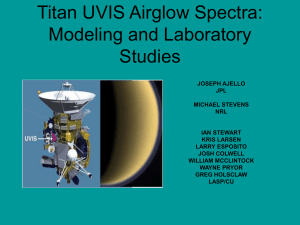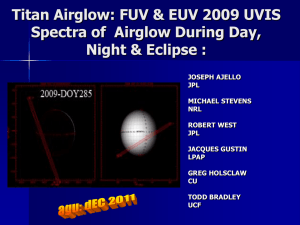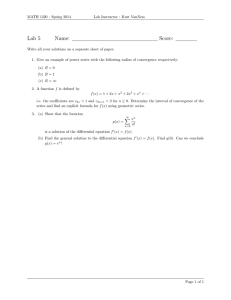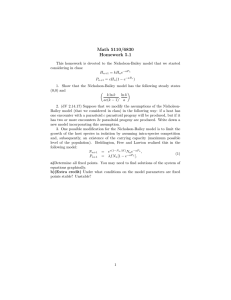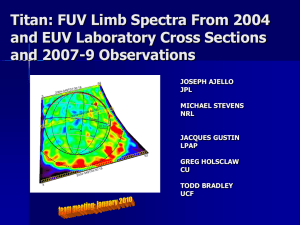Titan airglow spectra from Cassini Ultraviolet Imaging Spectrograph (UVIS): EUV analysis
advertisement
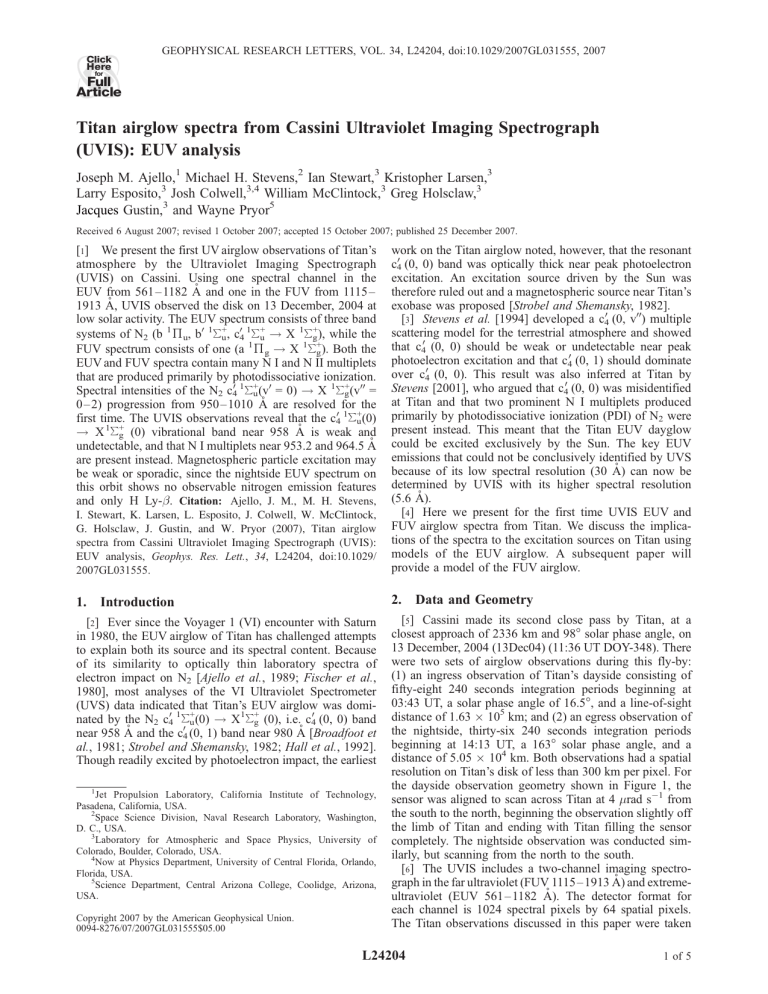
Click Here GEOPHYSICAL RESEARCH LETTERS, VOL. 34, L24204, doi:10.1029/2007GL031555, 2007 for Full Article Titan airglow spectra from Cassini Ultraviolet Imaging Spectrograph (UVIS): EUV analysis Joseph M. Ajello,1 Michael H. Stevens,2 Ian Stewart,3 Kristopher Larsen,3 Larry Esposito,3 Josh Colwell,3,4 William McClintock,3 Greg Holsclaw,3 Jacques Gustin,3 and Wayne Pryor5 Received 6 August 2007; revised 1 October 2007; accepted 15 October 2007; published 25 December 2007. [1] We present the first UV airglow observations of Titan’s atmosphere by the Ultraviolet Imaging Spectrograph (UVIS) on Cassini. Using one spectral channel in the EUV from 561– 1182 Å and one in the FUV from 1115– 1913 Å, UVIS observed the disk on 13 December, 2004 at low solar activity. The EUV spectrum consists of three band P P P systems of N2 (b 1!u, b0 1 +u , c04 1 +u ! X 1 P+g ), while the FUV spectrum consists of one (a 1!g ! X 1 +g ). Both the EUV and FUV spectra contain many N I and N II multiplets that are produced primarily by photodissociative ionization. P P Spectral intensities of the N2 c40 1 +u (v0 = 0) ! X 1 +g (v00 = 0 – 2) progression from 950– 1010 Å are resolved for the 0 1P+ (0) first time. The UVIS observations reveal that the c 4 u P ! X 1 +g (0) vibrational band near 958 Å is weak and undetectable, and that N I multiplets near 953.2 and 964.5 Å are present instead. Magnetospheric particle excitation may be weak or sporadic, since the nightside EUV spectrum on this orbit shows no observable nitrogen emission features and only H Ly-b. Citation: Ajello, J. M., M. H. Stevens, I. Stewart, K. Larsen, L. Esposito, J. Colwell, W. McClintock, G. Holsclaw, J. Gustin, and W. Pryor (2007), Titan airglow spectra from Cassini Ultraviolet Imaging Spectrograph (UVIS): EUV analysis, Geophys. Res. Lett., 34, L24204, doi:10.1029/ 2007GL031555. work on the Titan airglow noted, however, that the resonant c40 (0, 0) band was optically thick near peak photoelectron excitation. An excitation source driven by the Sun was therefore ruled out and a magnetospheric source near Titan’s exobase was proposed [Strobel and Shemansky, 1982]. [3] Stevens et al. [1994] developed a c40 (0, v00) multiple scattering model for the terrestrial atmosphere and showed that c40 (0, 0) should be weak or undetectable near peak photoelectron excitation and that c40 (0, 1) should dominate over c40 (0, 0). This result was also inferred at Titan by Stevens [2001], who argued that c40 (0, 0) was misidentified at Titan and that two prominent N I multiplets produced primarily by photodissociative ionization (PDI) of N2 were present instead. This meant that the Titan EUV dayglow could be excited exclusively by the Sun. The key EUV emissions that could not be conclusively identified by UVS because of its low spectral resolution (30 Å) can now be determined by UVIS with its higher spectral resolution (5.6 Å). [4] Here we present for the first time UVIS EUV and FUV airglow spectra from Titan. We discuss the implications of the spectra to the excitation sources on Titan using models of the EUV airglow. A subsequent paper will provide a model of the FUV airglow. 1. Introduction 2. Data and Geometry [2] Ever since the Voyager 1 (VI) encounter with Saturn in 1980, the EUV airglow of Titan has challenged attempts to explain both its source and its spectral content. Because of its similarity to optically thin laboratory spectra of electron impact on N2 [Ajello et al., 1989; Fischer et al., 1980], most analyses of the VI Ultraviolet Spectrometer (UVS) data indicatedPthat Titan’sPEUV airglow was dominated by the N2 c40 1 +u (0) ! X 1 +g (0), i.e. c40 (0, 0) band near 958 Å and the c04 (0, 1) band near 980 Å [Broadfoot et al., 1981; Strobel and Shemansky, 1982; Hall et al., 1992]. Though readily excited by photoelectron impact, the earliest [5] Cassini made its second close pass by Titan, at a closest approach of 2336 km and 98° solar phase angle, on 13 December, 2004 (13Dec04) (11:36 UT DOY-348). There were two sets of airglow observations during this fly-by: (1) an ingress observation of Titan’s dayside consisting of fifty-eight 240 seconds integration periods beginning at 03:43 UT, a solar phase angle of 16.5°, and a line-of-sight distance of 1.63 105 km; and (2) an egress observation of the nightside, thirty-six 240 seconds integration periods beginning at 14:13 UT, a 163° solar phase angle, and a distance of 5.05 104 km. Both observations had a spatial resolution on Titan’s disk of less than 300 km per pixel. For the dayside observation geometry shown in Figure 1, the sensor was aligned to scan across Titan at 4 mrad s1 from the south to the north, beginning the observation slightly off the limb of Titan and ending with Titan filling the sensor completely. The nightside observation was conducted similarly, but scanning from the north to the south. [6] The UVIS includes a two-channel imaging spectrograph in the far ultraviolet (FUV 1115– 1913 Å) and extremeultraviolet (EUV 561 –1182 Å). The detector format for each channel is 1024 spectral pixels by 64 spatial pixels. The Titan observations discussed in this paper were taken 1 Jet Propulsion Laboratory, California Institute of Technology, Pasadena, California, USA. 2 Space Science Division, Naval Research Laboratory, Washington, D. C., USA. 3 Laboratory for Atmospheric and Space Physics, University of Colorado, Boulder, Colorado, USA. 4 Now at Physics Department, University of Central Florida, Orlando, Florida, USA. 5 Science Department, Central Arizona College, Coolidge, Arizona, USA. Copyright 2007 by the American Geophysical Union. 0094-8276/07/2007GL031555$05.00 L24204 1 of 5 L24204 AJELLO ET AL.: CASSINI UVIS AIRGLOW SPECTRA L24204 between 920 and 1020 Å. The signal due to these two contaminations (in counts/pixel/sec) rose fairly smoothly from 0.00049 at 561 Å to 0.00071 at 920 Å, dropped rapidly to zero at 1020 Å, and rose again from zero at 1125 Å to 0.00045 at 1165 Å. 3. N2 Spectroscopy Figure 1. This UVIS EUV image of Titan was taken on 13Dec04 from approximately 03:30:18 – 07:30:18 UTC, with the beginning of the observation at the bottom of the image. The UVIS field-of-view is shown from sensor pixel three to sixty-two. The vertical axis is instrument readout time. The image color table shows the relative integrated intensity of EUV signal from 983– 988 Å plus 1082 – 1087 Å, regions of two strong emission features (Table 2), with red indicating the greatest intensity. The clear boundary of the N2 emissions occurs at a tangent altitude of 1200 km (black dashed line). The size of the EUV slit relative to Titan varies during the observation due to Cassini’s motion relative to Titan, from a line-of-sight distance of 160,000 km at the beginning of the observation to 85,000 km at the end. The red line indicates the terminator at the mid-point of the observation, the black star is the sub-solar point and the white star is the anti-ram direction. The disk data shown herein were averaged beginning at 03:43 UT so that the bright emissions on Titan’s limb are not included in the analysis of spectral content. [8] The strongest dipole-allowed transitions of N2 occur in the EUV. The excitation of the N2 Rydberg and valence (RV) states present in the EUV plays a role in establishing the physical composition of the Titan atmosphere. The P electronic transitions proceed from the X 1 +g ground-state to five closely spaced (12 – 15 eV) RV states. The RV bands are the source of the observed Titan molecular emissions in the EUV. Three of these RV states are the highly-perturbed P P b 1!u, b0 1 +u , and c40 1 +u states that are weakly to strongly predissociated and have significant emission cross sections [e.g., James et al., 1990]. The other two RV states, the c3 1 !u and o3 1!u states, are 100% predissociated by the triplet C, C0 3!u states [Lewis et al., 2005]. These five singletungerade states, when they predissociate, eject fast N-atoms (>1 eV) through the N(4So) + N(2Do) and N(4So) + N(2Po) dissociation limits located at 12.1 eV and 13.3 eV, respectively. [9] Stevens [2001] found that multiple scattering of the c40 (0, 0) band near peak photoelectron excitation enhances c40 (0,v00 = 0,1) radiative loss by predissociation by 3 times the optically thin case (<1012 cm-2 column density). In a thick atmosphere like Titan (>1016 cm-2 column density), the RV predissociation yield increases from 80% to 90% due to this enhancement from the c40 (0, v00) system. We show Table 1, which is a revision of Table 6 by James et al. [1990], listing the excitation, emission, and predissociation cross sections at 100 eV of the RV states for optically thin and thick media. Table 1 shows that the ratio of fast-atoms (1 eV) ejected in a predissociation process per N2 photon observed is 14:1. The EUV intensity is therefore a measure of the atmospheric dissociation rate. The remaining N2 dissociation cross section by electrons at 100 eV to other Table 1. Updated Summary of 100 eV, 300 K Excitation, Emission and Predissociation Cross Sections for N2 Rydberg and Valence States from James et al. [1990]a State with a spectral resolution of 5.6 Å and a rectangular field of view of 2.0 59 mrad. [7] Calibration of the EUV and FUV data follows the preflight measurements as described by Esposito et al. [2004]. Additionally, an empirically derived background noise level of 4.0 104 counts s1 pixel1 due to the radioisotope thermoelectric generators is removed and a flat-field correction derived from observations of Spica [Steffl et al., 2004] is applied. There are also two contaminating signals that affect the recorded EUV spectra. The first is due to dispersed Ly-a from the target, which is focused just beyond the long-wavelength end of the EUV detector. About 4% of this light is scattered on to the detector, longward of 1125 Å. The second is due to a small light leak that allows undispersed interplanetary Ly-a to reach the EUV detector. One-third of the detector (at the longwavelength end) is in shadow; the shadow’s penumbra falls P c40 1 u+ 0 1P + b u b 1!u c3 1!u o3 1!u totals a Qex (1019 cm2) a,b,d,e 179 128a,f 121a 161a 75a 664 Qem (1019 cm2) a,d c,d 120 (76) 15.5a,f 6.1a 0a 0a 142 (98) Qpre (1019 cm2) 59a,b,d (103)c,d 112.5a,f 115a 161a 75a 522a(566)a Thin Predissociation (Fast N I atom) yield (Qpre/Qex) = 522/664 = 79% EUV photon yield = 21%. Thick Predissociation (Fast N I atom) yield (Qpre/Qex) = 566/664 = 85% EUV photon yield = 15%. b James et al. [1990], Ajello et al. [1998] where Qex = Qem + Qpre, including hpre(c40 ) for v0 = 0, 3 and 4. c Liu et al. [2005] v0 = 0 at 150 K, hpre(c40 ) = 25%, at 300 K, hpre(c40 ) = 31%. d Estimated optically thick effective cross section for Titan [Stevens, 2001]. e Includes additional c40 (0, v00 = 6 – 12) bands [Bishop et al., 2007]. f Includes revised Qex(v0 = 0) = 134 (units of 1019 cm2). Note: c40 oscillator strength revisions will induce changes to this cross section value. g 01 + b Su value based on correction to v0 = 9 and 11 emission cross sections [Walter et al., 1994]. 2 of 5 L24204 AJELLO ET AL.: CASSINI UVIS AIRGLOW SPECTRA L24204 Figure 2. (top). Model fit to UVIS dayglow spectrum from 13Dec04. The regression model (red) includes three independent vectors (totals indicated, see text) and fits the H Ly-b feature near 1026 Å, separately. Two N I multiplets at 953.2 and 964.5 Å [Stevens, 2001] account for most of what was originally identified as c40 (0, 0) [Broadfoot et al., 1981]. The optically thin c40 (0) ! X(0) band that was removed from vector 1 (20 eV spectrum) is shown in dotted-light blue and the loss in area of the c40 (0, 0) band represents multiple-scattering predissociation of N2. The composite integral in red includes the H Ly-b intensity of 1.7 R. (bottom). Nightglow with a H Ly-b intensity of 0.1 R. dissociating states, including ions, observed by Winters [1966] contributes another factor of 2 to 3 to this ratio (see discussion by Ajello and Ciocca [1996]). [10] PDI [Bishop and Feldman, 2003] causes the appearance of a population of fast N and N+ atoms. The solar XUV spectral range (0 –450 Å) that produces 30 eV photoelectrons can simultaneously ionize, dissociate and excite P N2 through unbound repulsive states (e.g., the N+2 (H 2 +g ) state), leading to excited N and N+ fragments [Meier et al., 1991; Samson et al., 1991]. [11] Liang et al. [2007] have quantitatively calculated photodissociative excitation (PDE) of N2 by the solar spectrum in the EUV (827– 1000 Å). This process is also an important mechanism for electronically exciting and predissociating N2 into two fast N-atoms through the RV states. 4. Spectral Analysis [12] The UVIS disk-averaged spectrum over the spectral range of 900– 1140 Å is shown in Figure 2 (top). The 16 indicated dayglow features are identified in Table 2, based on the work of Ajello et al. [1989] and James et al. [1990] and unpublished laboratory high resolution spectra as well as the terrestrial airglow spectra of Bishop and Feldman [2003]. Laboratory spectra (0.2 Å FWHM) have shown the presence of about 200 spectral features from electronexcited N2 over the same EUV spectral range (J. M. Ajello et al., manuscript in preparation, 2007). There are several (10) emissions on average for each feature number in Figure 2 (top), but we list only the strongest in Table 2. The strongest feature is feature number 14, the N II multiplet (g 3P 3Po) near 1085 Å with an intensity of 2.3 Rayleigh Table 2. Identification of Strong Titan Emission Features l(Å) 1 2 3 4 5 6 7 8 9 10 11 12 13 14 15 16 a 909 915 928 944 953 965 980 987 1007 1026 1034 1054 1070 1086 1098 1135 4pIa,b(R) Identificationc 0.50 0.32 0.41 1.56 0.84 1.39 1.47 1.45 1.46 1.71 0.46 0.56 0.33 2.31 0.51 1.33 b0(16,2), b0(12,1) N ( P- P ) b0(9,1), c40 (6,4) c40 (4,3), c40 (3,2), b0(9,2), c40 (6,5), b0(16,4) N(4So-4D), N(4So-4P) c40 ((1,1), N(4So-4P), c40(3,3), c40 (4,4) c40 (0,1) c40 (3,4), c40 (4,5), c40 (6,7) c40 (0,2), c40 (3,5), c40 (4,6), b(1,1), c40 (6,8), b0(9,5) H Ly-b b(1,2), b0(9,6) N(2Do-2P), b0(11,7), b(1,3), b0(3,5) b0(11,8), N(2Do-2D), N(2Do-2P), N(2Do-2F) N+(3Po-3Do) N(2Do-2P), N(2Do-2D), N(2Do-2F), b0(9,9), b(1,5) N(4So-4P) c40 (4,1), N(4S-4P), + 3 3 o Total observed UVIS EUV: disk intensity (900 – 1140 Å) is 16.6 R. VI UVS: UVIS comparison; total observed UVIS intensity (920 – 1015 Å) is 8.6 R vs. total modeled VI intensity 920 – 1015 Å is 20.9 R. c Identifications from Ajello et al. [1989], James et al. [1990], Bishop and Feldman [2003], and unpublished high resolution (0.2 Å FWHM) laboratory spectra. 3 of 5 b L24204 AJELLO ET AL.: CASSINI UVIS AIRGLOW SPECTRA Figure 3. The FUV limb spectrum of 13Dec04 with the same geometry and timing of the EUV observation in Figure 2. A laboratory spectrum of electron impact induced fluorescence at 30 eV is over-plotted with the FUV spectrum with the two spectra normalized at 1383Å (2,0). The FUV spectrum indicates extensive Rayleigh scattering longward of 1500Å. The principal features in the plot with associated disk intensities are: the LBH bands P (a1!g ! X1 g+) at 43 R, N I 1200 Å at 6.8 R, H I Ly a at 208 R, N I 1243 Å at 0.6 R, and N I 1493 Å at 3 R. The statistical error bar (18%) for the peak pixel LBH (2,0) band at 1383 Å is indicated. (R). Whereas VI observed a few blended spectral features, the UVIS dayglow spectrum indicates 16 features, with the c40 (0, 0) band conspicuous by its absence. The S/N is estimated to be 6 for the c04 (4,3) and c40 (3,2) bands at 943 Å (Feature 6) increasing to 200 at the N II(1085Å) multiplet (Feature 14). [13] The disk-averaged nightglow spectrum in Figure 2 (bottom) of this orbit indicates a weak H Ly b spectral feature of 0.1 R intensity, partially produced by interplanetary Ly b. There were no detectable N2 emissions from particle impact. This is a surprising result, since Titan was well inside Saturn’s magnetosphere at the time of the nightside observation (K. Khurana, personal communication, 2007). Early publications of the VI Titan observations advocated varying amounts of excitation of the EUV by magnetospheric electrons [Strobel and Shemansky, 1982]. A survey of twenty-three Cassini orbits, that viewed the entirety of Titan’s dayside and night side, have shown that magnetospheric excitation of the nightside disks occurs in the FUV spectra, ranging from 0% (e.g. 13Dec04) to 50% (e.g., 20May06) of the FUV intensity of the dayside emissions [Larsen et al., 2007]. This is consistent with analysis of VI UVS data by Hall et al. [1992], who found that nightside N2 EUV emissions were 20% of dayside emissions. It cannot be ruled out that soft magnetospheric electrons may produce a detectable signal of c40 (0, 0) on other orbits, since other orbits contain EUV nightside emissions. [14] The regression model in Figure 2 (top) consists of three independent vectors: (1) an optically thin 20 eV electron impact laboratory fluorescence spectrum (simulating the airglow spectrum of the N2 bands) measured at 0.6 Å FWHM with the ad hoc removal of the c40 (0, v00 = 0 –2) L24204 progression, which dominates the optically thin laboratory spectrum (in blue); (2) the calculated multiple scattered emergent spectrum of the c04 (0, v00 = 0– 2) progression produced at the peak photoelectron production altitude and transmitted through an optically thick medium (in green) [Stevens, 2001] and (3) a PDI spectrum of N2 to produce the N I and N II EUV emissions, based on the list of relative intensities given by Bishop and Feldman [2003] down to 980 Å, to which we add the N I multiplets at 952 and 964 Å observed in the laboratory (in light blue) [Meier et al., 1991]. The multiple scattering model includes the accidental resonance of the c40 (0, 1) band with the 100% predissociating b(2, 0) band [Stevens et al., 1994]. The H Ly-b feature near 1026 Å is fitted separately. We convolved each vector with the slit function prior to the regression analysis. [15] The result from the regression in Figure 2 (top) (red) matches the UVIS data well. The modeling results for each vector are: (1) the c40 (0, v00 = 0,1,2) bands produce 1.6 R; (2) the N I and N II lines yield 5.5 R and the remaining N2 bands furnish 8.7 R. The c40 (0, 1) band dominates the intensity of the c40 (0, v00) progression and is 1.1 R, which is about a factor of five less than the c40 (0, 1) intensity inferred from lower resolution VI UVS data near solar maximum [Strobel et al., 1991]. We have incorporated the calibration revision to the UVS EUV data [Holberg et al., 1991]. [16] We show the FUV disk spectrum from 1150– 1850 Å in Figure 3 and compare it to a 30 eV laboratory electron in the impact spectrum. The principal N2 molecular band P FUV is the optically forbidden N2(a 1!g ! X 1 +g ) LBH band system [Strobel and Shemansky, 1982; Ajello and Shemansky, 1985]. By normalizing the laboratory spectrum to the LBH (2, 0) band at 1383 Å we can estimate the radiated power in the LBH bands. The longer wavelength LBH bands are blended with the signal from the Rayleigh scattering of the solar flux (wavelengths greater than 1500 Å). The FUV intensities are limb-brightened with an integrated (1273 – 2600 Å) LBH intensity of 43 R on the disk and 65 R on the limb. More exact FUV intensities will be given in the FUV paper (J. M. Ajello et al., manuscript in preparation, 2007), which properly considers reflected sunlight. In contrast, the VI UVS intensities for the LBH bands were 96 R from the disk and 290 R from the limb, near solar maximum (1980), a factor of 2 – 4 greater than the result for UVIS at low solar activity. The FUV limb spectra define a peak altitude of the airglow layer at 1100 km. We estimate the emergent UV airglow intensity (800– 2600 Å) from Titan from N2, N I, and N II, emissions at low solar activity (13Dec04) to be 8 107 Watts, compared to a TIMED SEE (Thermosphere Ionosphere Mesosphere Energetics Dynamics Solar EUV Experiment) solar XUV (0 – 450 Å) input of 1.0 109 Watts [Woods et al., 2005]. We used SEE XUV data of 13Dec04 to calculate the solar irradiance into an area of radius of 1000 km atmosphere altitude plus surface radius. [17] We estimate the N2 loss rate from three dominating processes that create fast N-atoms: PE (8 108 atoms/ cm2s1), PDI (2 108 atoms/cm2s1) and PDE (3 108 atoms/cm2s1 [Liang et al., 2007]. The N2 dissociation rate is a function of the N2 emergent intensity in the EUV. A global (hemispheric) total of 1 1027 atoms s1 is created. The majority of the fast N-atoms from the 4 of 5 L24204 AJELLO ET AL.: CASSINI UVIS AIRGLOW SPECTRA thermosphere are converted back into N2 [Yung et al., 1984]. Dissociation of the atmosphere has led to 20% loss of N2 over geologic time through creation of nitriles and deposition of organics [Yung et al., 1984]. Some upward moving atomic N, formed high in the thermosphere, can escape the exobase (1300 km) into the Saturn magnetosphere [Ajello and Ciocca, 1996]. 5. Summary [18] The first EUV and FUV airglow results from the UVIS experiment at Titan indicate a source of excitation different than originally proposed following the VI UVS observations in 1980 [Broadfoot et al., 1981; Strobel and Shemansky, 1982; Strobel et al., 1991]. We find that the N2 c40 (0, 0) band near 958 Å is weak and undetectable by UVIS and that N I multiplets near 958 Å are present instead [Stevens, 2001]. The main excitation source does not need to be placed near the exobase of Titan where the c40 (0, 0) band is optically thin, as early work proposed. [19] The emergent intensities observed by the UVIS experiment at low solar activity are substantially less than those observed by the VI UVS, as expected from the corresponding levels of solar activity during each measurement. The brightest region of the EUV (920 – 1015 Å) is a factor of 3 less than the intensity inferred by Stevens [2001] for the same N2 features observed by UVS and the FUV emissions are a factor of 2 – 4 less than earlier UVS analyses [Strobel et al., 1991]. This is generally consistent with solar cycle XUV variation for solar maximum to low solar activity of 3.9:1 using the TIMED SEE Experiment for low solar activity and the values of Stevens [2001] for the 1980 solar maximum. The UVIS results confirm the work of Stevens [2001], who argued that the c40 (0, 0) band was misidentified in VI UVS observations and that the source of the EUV airglow was in fact solar, driven by PE and PDI. Thus Titan’s EUV and FUV airglow is more similar to the terrestrial airglow [Bishop et al., 2007] than once thought. [20] Acknowledgments. The research was carried out at the Jet Propulsion Laboratory (JPL), California Institute of Technology. The work was supported by the NASA Planetary Atmospheres Program and the Cassini Project. JMA acknowledges a JPL sabbatical leave at the University of Colorado. MHS was supported by the Office of Naval Research. References Ajello, J. M., G. James and M. Ciocca (1998), High Resolution EUV Emission Spectroscopy of the N2 c0 v0 = 3 and 4 Levels by Electron Impact, J. Phys. B, 31, 2437. Ajello, J. M., and M. Ciocca (1996), Fast nitrogen atoms from dissociative excitation of N2 by electron impact, J. Geophys. Res., 101, 18,953. Ajello, J. M., and D. E. Shemansky (1985), A re-examination of important N2 cross sections by electron impact with application to the dayglow: The Lyman-Birge-Hopfield band system and NI (119.99 nm), J. Geophys. Res., 90, 9845. Ajello, J. M., G. K. James, B. O. Franklin, and D. E. Shemansky (1989), impact: Medium resolution studies of EUV emission from N2 by electron P Vibrational perturbations and cross sections of the c0 1 +g and b0 1!g states, Phys. Rev. A., 40, 3524. Bishop, J., and P. D. Feldman (2003), Analysis of the Astro-1/Hopkins Ultraviolet Telescope EUV-FUV dayside nadir spectral radiance measurements, J. Geophys. Res., 108(A6), 1243, doi:10.1029/2001JA000330. L24204 Bishop, J., M. H. Stevens, and P. Feldman (2007), Molecular nitrogen Carroll-Yoshino v0 = 0 fluorescence in the thermospheric dayglow as seen by the Far Ultraviolet Explorer, J. Geophys. Res., 112, A10312, doi:10.1029/2007JA012389. Broadfoot, A. L., et al. (1981), Extreme UV observations from Voyager 1 encounter of Saturn, J. Geophys. Res., 86, 8259. Esposito, L., et al. (2004), The Cassini Ultraviolet Imaging Spectrograph investigation, Space Sci. Rev., 115, 299. Fischer, F., G. Stasek, and G. Schmidtke (1980), Identification of auroral EUV emissions, Geophys. Res. Lett., 7, 1003. Hall, D., D. Shemansky, and T. Tripp (1992), A re-analysis of Voyager UVS observations of Titan, in Symposium on Titan, Eur. Space Agency Spec. Publ., 338, 69. Holberg, J. B., B. Ali, T. E. Carone, and R. S. Polidan (1991), Absolute farultraviolet spectrophotometry of hot subluminous stars from Voyager, Astrophys. J., 375, 716. James, G. K., J. M. Ajello, B. O. Franklin, and D. E. Shemansky (1990), Medium resolution studies of EUV emission from N2 by electron impact: The effect of predissociation on emission cross sections of the b 1!u state’, J. Phys. B., 23, 2055. Larsen, K., J. M. Ajello, and A. I. F. Stewart (2007), Titan’s nitrogen emissions: Spatial, temporal, and hemispherical distribution and variability as measured by Cassini-UVIS, Eos Trans. AGU, Fall Meet. Suppl., in press. Lewis, B., S. Gibson, W. Zhang, H. Brion, and J. Robbe (2005), Predissociation mechanisms for the lowest 1!u states of N2, J. Chem. Phys., 122, 144302, doi:10.1063/1.1869986. Liang, M., A. Heays, B. Lewis, S. Gibson, and Y. Yung (2007), Source of nitrogen isotope anomaly in HCN in the atmosphere of Titan, Astrophys. J., 664, L115 – L118, doi:10.1086/520881. Liu, X., D. E. Shemansky, M. Ciocca, I. Kanik, and J.PM. Ajello (2005), P Analysis of the physical properties of the N2 c0 1 +u (0)- X 1 +g (0) transition, Ap. J., 623, 579. Meier, R., J. Samson, Y. Chung, E. Lee, and S. He (1991), Production of N+* from N2 + hn: Effective EUV emission yields for laboratory data and dayglow data, Planet Space Sci., 39, 1,197. Samson, J. A. R., Y. Chung, and E. M. Lee (1991), Excited ionic and neutral fragments produced by dissociation of the N+2 * H band, J. Chem. Phys., 95, 717. Steffl, A. J., A. I. F. Stewart, and F. Bagenal (2004), Cassini UVIS observations of the Io plasma torus. I. Initial results, Icarus, 172, 78. Stevens, M. (2001), The EUV airglow of Titan: Production and loss of N2 c04 (0)-X, J. Geophys. Res., 106, 3685. Stevens, M. H., R. R. Meier, R. Conway, and D. Strobel (1994), A resolution of the N2 Carroll-Yoshino c40 (0)-X band problem in the Earth’s atmosphere, J. Geophys. Res., 99, 417. Strobel, D. F., and D. E. Shemansky (1982), EUV emission from Titan’s upper atmosphere: Voyager 1 encounter, J. Geophys. Res., 87, 1361. Strobel, D. F., R. R. Meier, M. E. Summers, and D. J. Strickland (1991), Nitrogen airglow sources: Comparison of Triton, Titan, and Earth, Geophys. Res. Lett., 18, 689. Walter, C., P. C. Cosby, and H. Helm (1994), Predissociation quantum yields of singlet nitrogen, Phys. Rev. A, 50, 2930. Winters, H. F. (1966), Ionic adsorption and dissociation cross section of nitrogen, J. Chem. Phys., 44, 1,472. Woods, T. N., F. G. Eparvier, S. M. Bailey, P. C. Chamberlin, J. Lean, G. J. Rottman, S. C. Solomon, W. K. Tobiska, and D. L. Woodraska (2005), Solar EUV Experiment (SEE): Mission overview and first results, J. Geophys. Res., 110, A01312, doi:10.1029/2004JA010765. Yung, Y., M. Allen, and J. Pinto (1984), Photochemistry of the atmosphere of Titan: Comparison between model and observations, Astrophys. J. Suppl. Ser., 55, 464. J. M. Ajello, Jet Propulsion Laboratory, California Institute of Technology, Pasadena, CA 91109, USA. (jajello@mail.jpl.nasa.gov) J. Colwell, L. Esposito, J. Gustin, G. Holsclaw, K. Larsen, W. McClintock, and I. Stewart, Laboratory for Atmospheric and Space Physics, University of Colorado, Boulder, CO 80303, USA. W. Pryor, Science Department, Central Arizona College, Coolidge, AZ 85228, USA. M. H. Stevens, Space Science Division, Naval Research Laboratory, Washington, DC 20375, USA. 5 of 5
